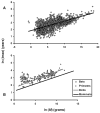An analysis of the relationship between metabolism, developmental schedules, and longevity using phylogenetic independent contrasts
- PMID: 17339640
- PMCID: PMC2288695
- DOI: 10.1093/gerona/62.2.149
An analysis of the relationship between metabolism, developmental schedules, and longevity using phylogenetic independent contrasts
Abstract
Comparative studies of aging are often difficult to interpret because of the different factors that tend to correlate with longevity. We used the AnAge database to study these factors, particularly metabolism and developmental schedules, previously associated with longevity in vertebrate species. Our results show that, after correcting for body mass and phylogeny, basal metabolic rate does not correlate with longevity in eutherians or birds, although it negatively correlates with marsupial longevity and time to maturity. We confirm the idea that age at maturity is typically proportional to adult life span, and show that mammals that live longer for their body size, such as bats and primates, also tend to have a longer developmental time for their body size. Lastly, postnatal growth rates were negatively correlated with adult life span in mammals but not in birds. Our work provides a detailed view of factors related to species longevity with implications for how comparative studies of aging are interpreted.
Figures




References
-
- Austad SN. Diverse aging rates in metazoans: targets for functional genomics. Mech Ageing Dev. 2005;126:43–49. - PubMed
-
- Miller RA. Kleemeier award lecture: are there genes for aging? J Gerontol A Biol Sci Med Sci. 1999;54A:B297–B307. - PubMed
-
- de Magalhães JP. Species selection in comparative studies of aging and antiaging research. In: Conn PM, editor. Handbook of Models for Human Aging. Burlington, MA: Elsevier Academic Press; 2006. pp. 9–20.
-
- Finch CE. Longevity, Senescence, and the Genome. Chicago and London: The University of Chicago Press; 1990.
-
- Speakman JR. Correlations between physiology and lifespan–two widely ignored problems with comparative studies. Aging Cell. 2005;4:167–175. - PubMed
Publication types
MeSH terms
Grants and funding
LinkOut - more resources
Full Text Sources
Medical

